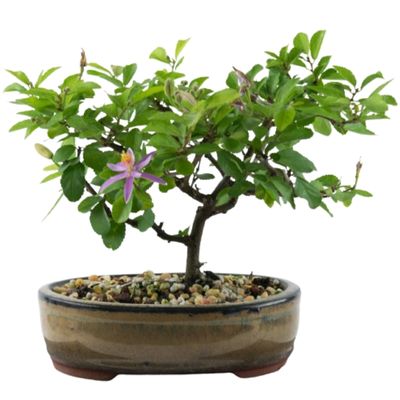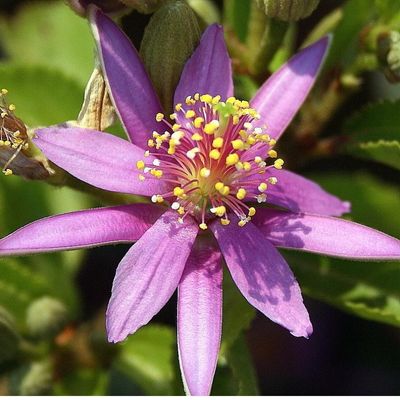
Lavender Star Flower
(Grewia occidentalis)
Country of Origin : Southern Africa
Bonsai Styles : Informal upright, cascade
Zone : 9 – 11
There is no doubt that this evergreen vigorous and fast growing shrub (also known as crossberry or buttonwood plant or African starbush) is a wise choice for making a small bonsai.
Lavender star bonsai has tiny, tapering, and glossy dark green leaves.
This tree also makes for a beautiful flowering bonsai as it grows star-shaped purple colored flowers almost 3 times a year.
In particular, during the months of October through January and in the early spring, there is a greater abundance of blooms.
Occasionally, the flowers are followed by fruit that has a berrylike appearance and hangs in sets of four along the stem.
Initially, the fruits are dark brown in color, but as they mature, they become reddish brown in color.
It also requires less maintenance, making it a good choice for bonsai beginners. Furthermore, it is also a good choice for making an indoor bonsai tree.

Lavender star flower

The 4-lobed fruit grows with a cross in the center. Hence aptly named crossberry plant.
These berries also attract birds and butterflies.
The fruit will ripe and turn red in color, mostly in the months from January to May.
Best location to keep Lavender Star Flower Bonsai
Lavender star flower bonsai prefers full sun and will do well when kept outdoors in the growing season.
However, it can also be kept indoors in a bright sunny location. (Southern or western window or windowsill). Almost 6 hours of sunlight is good for its growth.
Remember that this plant will attract butterflies and birds.
In the growing season, an ideal temperature range for the tree to do well is 65°F to 70°F (18°C to 21°C).
In the time of winter, move the bonsai container to a protected shed when the temperature drops below 50°F (10°C).
It is a drought and frost hardy plant, however do not expose the tree to harsh cold temperatures. The minimum temperature the tree can withstand is 23°F (-5°C). But it will surely die if exposed to such temperatures for prolonged periods.
IMP: Refer sunlight requirements for indoor plants for more indoor gardening ideas. Also, refer to do bonsai trees need sunlight for more indoor and outdoor bonsai location ideas.
Propagation of Lavender Star Flower
Lavender star flower plant can be propagated easily by stem cuttings and seeds.
Seeds usually take 2-3 weeks to germinate. Keep it exposed to a temperature of 70°F (21°C), for ensuring good germination.
If trying to grow it by using stem cuttings, take the stem cutting from new growth in spring. However, keep in mind that the plant should be mature ( has flowered for 1-2 seasons already).
Watering Lavender Star Flower Bonsai
Lavender star flower tree is fairly drought tolerant when it has established. It is, however, extremely important to ensure that the tree is properly watered when grown in containers.
It is not necessary to keep the bonsai soil moist at all times. It is important to water the tree when the soil feels dry to the touch, but do not overwater it.
Depending on your environment, water more in summer season and in winter reduce the amount of water.
Although these trees prefer moist climate, they can also grow in dry climates. You can spray mist on the foliage to keep the surroundings moist.
Read watering bonsai tree for more details.
Wiring Lavender Star Flower Bonsai
Since the tree is very easy to work with, this tree can be wired at any time of the year.
Preferably use aluminum wire for wire training the plant.
Pruning Lavender Star Flower Bonsai
When to prune Lavender Star Flower bonsai?
How to prune Lavender Star Flower bonsai?
In terms of growth, lavender star flowers are vigorous plants.
At any time of the year when the shoots of this species have elongated, it is possible to prune back the tips to two sets of leaves.
Avoid removing all the new growth of the tree. Keep some so that the tree can sustain its overall health.
As the tree is developing its shape, it is important to remove the flowers from the young trees in order to maintain the tree’s energy.
To maintain the bonsai style of mature specimens, you should prune them right after the blooms have fallen. This will also promote good next bloom.
Repotting Lavender Star Flower Bonsai
When to repot Lavender Star Flower bonsai?
Lavender Star Flower tree can be repotted every 2 years in spring.
You can prune the roots at the time of repotting. However, dont remove more than 1/3 of the root system.
You can use a basic free-draining bonsai soil mix as a potting soil.
OR
You can also use a mix of peat (or compost), sharp sand and loam in the ratio of 1:1:2.
Must Read: Bonsai Soil Recipes
Must read : Choosing the right bonsai container
Feeding Lavender Star Flower Bonsai
It is recommended that you fertilize your bonsai tree every week with a well-balanced fertilizer at half strength, and that you reduce the amount to once every two to three weeks in the winter.
Occasionally, supplement with a fertilizer that is good for acid loving plants such as azaleas and camellias. – (acid-based fertilizer).
It is easy for this species to become chlorotic (plant tissue starts becoming yellow). Once a year, it is a good idea to supplement with chelated iron to prevent problems in the future.
Read more about bonsai fertilizer and its application.
Diseases and pest of Lavender Star Flower Bonsai
This tree is generally free from pest and diseases.
Sometimes you can see some caterpillar which you can remove by hands. This can be due to the fact that they attract butterflies. These butterflies my leave their butterfly larvae on the tree.
In rare occasions, this tree can be attacked by aphids, scales and mealybugs.
Try and remove these insects by hands. Or take the bonsai outside and spray a gentle water jet on the tree to dislodge the insects.
This tree has a tendency of not responding to insecticides well. Insecticides will effect its growth and flowering density.
So, avoid insecticide as much as you can. You can try using some neem oil instead.
Lavender Star Flower bonsai care
Do not use alkaline soil. This will lead to yellowing of leaves.
Keep the tree protected from frost.
Fun fact : its bark has antiseptic properties. Its bark is grinded to make shampoo for hair and it can also be boiled and mushed to apply on wounds.
Lavender Star Flower bonsai is not toxic to cats and other pets.


